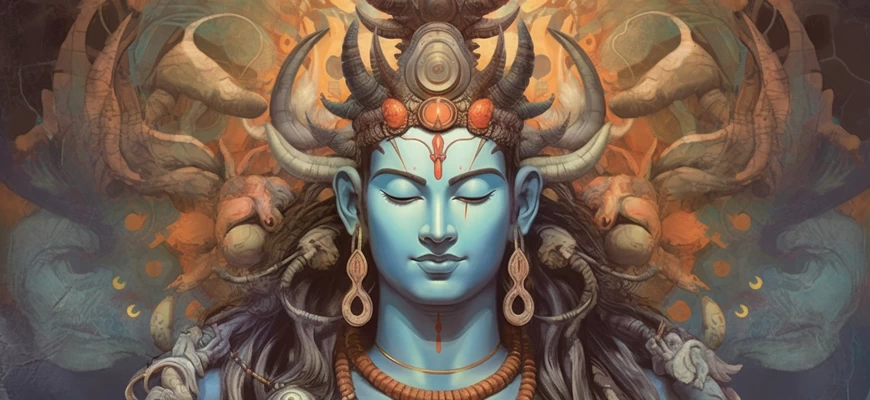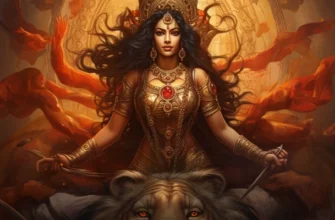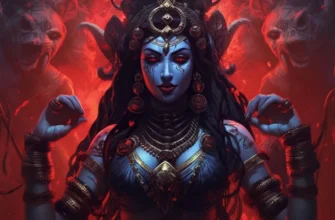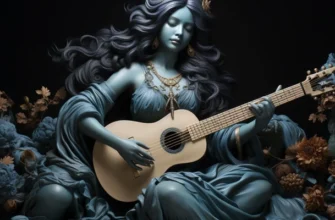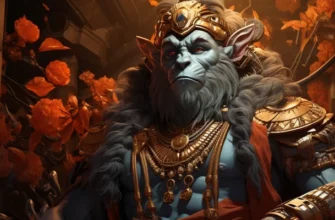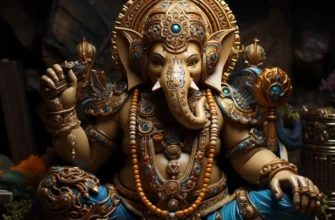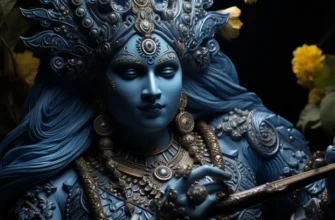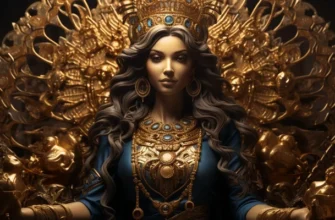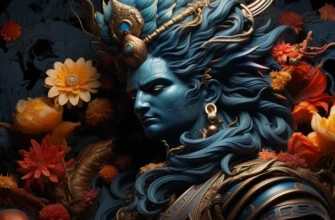Shiva, one of the most important gods of Hinduism, embodies the power of destruction and creation. He is known for his wisdom, calmness, and power. Shiva is also reflected in a variety of aspects such as Parameshwara, Ardhanarishwara, and others, each with its own unique meaning. His cult is revered around the world because of his influence on philosophy, art, and modern Indian culture. Festivals and rituals dedicated to Shiva attract thousands of worshippers, which emphasizes the importance of this god in Indian society.
- Definition of Shiva in the context of Hinduism
- Origin and legends
- History and evolution of the Shiva cult over the centuries
- Aspects and symbolism
- Symbolism of Shiva’s attributes
- The role of Shiva in modern Indian society
- The influence of the Shiva cult on Indian philosophy and art
- Modern rituals and festivals dedicated to Shiva
- The cult of Shiva in the modern world
- Global influence of the Shiva cult and its acceptance in Western countries
- The place of Shiva in the current Indian socio-political situation
- Conclusion
Definition of Shiva in the context of Hinduism
Shiva is one of the most important gods of Hinduism, symbolizing the power of destruction and creation. In Hinduism, Shiva is considered part of the holy trinity (trimurti), along with Vishnu and Brahma, who represent creation, preservation, and destruction in the universe. His cult is associated with art, philosophy, and various aspects of human life, which emphasizes his importance in the Indian spiritual and cultural heritage.
Shiva has a significance in Indian culture and religion that encompasses a variety of aspects:
Symbol of destruction and creation: Shiva represents an important aspect of life, from death and destruction to new beginnings and creation. This reflects the cyclical nature of the universe in Hinduism.
Calmness and wisdom: Shiva is also known for his wisdom and inner peace. He is an example of spiritual focus and meditation, and this inspires believers to explore their own inner world.
Cultural influence: The cult of Shiva has a significant influence on Indian music, art, and literature. He is often depicted in sculptures, paintings, and religious texts as a happy divine dancer.
Festivals and rituals: Festivals dedicated to Shiva, such as Maha Shivaratri, bring devotees together for prayers, meditation, and celebration. These rituals reinforce the community of the Indian people.
Overall, Shiva is an important symbol of Indian community and spiritual tradition, reflecting the diversity and richness of Indian culture and religion.
Origin and legends
The origins and legends associated with the god Shiva have deep roots in Hindu sacred texts and mythology. Some of the important legends include:
The legend of the wedding of Shiva and Parvati: It is said that Parvati, reincarnated as Sati, won the heart of Shiva through her ascetic devotion and humility.
The legend of the wedding of Shiva and Parvati is that Parvati, the daughter of the Himalayan mountains, fell in love with Shiva, the god of destruction and creation. She spent many years practicing asceticism to win his heart. At first, Shiva refused her proposals, but after numerous trials, he surrendered to her passion and loyalty. Their wedding became a symbol of the unity of two opponents – ascetic power and the power of nature, celebrating harmony and balance in the cosmic order.
The legend of the Nectar of Peace and Poison: In another legend, Shiva saved the world by drinking poison, which he expelled from his throat but left a feeling of peace in it.
The legend of the “Nectar of Tranquility and Poison” tells of an event when, during a divine process, Shiva drank the poison that had arisen on its way down his throat. This turned his throat blue, and he was nicknamed “Nilakanta” (one with a blue throat). Shiva saved the world from destruction by drinking poison, but he was in great pain. At that time, the gods gave him the nectar of peace, which reduced his pain and gave him inner harmony. This legend symbolizes Shiva’s inner strength and his ability to remain calm even in the most difficult situations.
The legend of Tandava: Shiva is known for his divine dance Tandava, which reflects the rhythmic choreography of life, destruction and creation.
The legend of Tandava is related to the divine dance of Shiva that took place in different historical periods. This dance is depicted as a powerful, energetic dance representing the power of destruction and creation in the universe. The legend says that through Tandava, Shiva is able to destroy all misery and adversity and makes the universe move into a new cycle of creation. This dance is considered to be one of the most powerful and beautiful in Indian mythology, symbolizing the rhythm of life, destruction and creation in the universe.
These legends not only reflect the essence of Shiva as a god of destruction and creation, but also provide key guidance on his role in Hinduism and his relationship with other gods and goddesses.
History and evolution of the Shiva cult over the centuries
The history and evolution of Shiva’s cult has deep roots in Hinduism, beginning with the ancient Vedas and Puranas. Throughout the centuries, his cult has undergone numerous changes, from being depicted as a god of destruction to being an original accompaniment in Indian life and culture.
In the Middle Ages and later, the cult of Shiva became an important part of the Buddhist and Sanskrit movements in India, and his images and stories became an integral part of Indian literature, art, and architecture.
In modern times, the cult of Shiva remains alive and dynamic, with its images and aspects existing in different regions of India. His festivals and rituals continue to inspire admiration and faith among his devotees, maintaining his importance in Indian society and culture for centuries.
Aspects and symbolism
The aspects and symbolism associated with the god Shiva have deep spiritual and cosmic meanings:
Parameshwara: Shiva in this aspect is the supreme deity who embodies absolute power and wisdom.
Ardhanarishvara: This aspect reflects Shiva and his consort Parvati in unity, emphasizing the balance of male and female energies in the universe.
Trishula: The symbolism of the trishula, Shiva’s trident, indicates his power over time, space, and energy, as well as the destruction of the infidel and change for the better.
Ganga: Shiva embodies the momentum of life through his association with the Ganga, which symbolizes holiness and purification.
Nataraja: This aspect of Shiva expresses his skill in dance as a manifestation of cosmic rhythm and harmony in the universe.
These aspects and symbolism help to reveal the deeper essence of Shiva as a god of destruction and creation, and show his significance in the spiritual life and culture of India.
Symbolism of Shiva’s attributes
Shiva’s attributes, such as trimanji, trishula, Ganga, and others, have deep symbolic meanings:
Trimanji: The trimanji are symbolic objects that include a drum, a flag, and a dead man’s head indicating Shiva’s hold over time, space, and energy, which symbolize the hold of the universe.
Trishula: The trishula, or trident, represents three serpents wrapped around a fork, which symbolizes Shiva’s trimutri – creation, preservation, and destruction. It celebrates Shiva’s power over life and the universe.
Ganga: Associated with holiness and purification, the Ganga descending from Shiva’s hair symbolizes vitality, purification, and renewal.
Ashes: Shiva is covered in ashes, which symbolizes his separation from the material world and his asceticism.
Snakas: The snakas that wrap around his body represent his control over fear and death, as well as his power over potential danger.
This symbolism helps to deepen the understanding of the important aspects of Shiva in Hinduism and reflects his greatness and power.
The role of Shiva in modern Indian society
In contemporary Indian society, Shiva plays a number of important roles covering a variety of areas:
Spiritual at the same time as philosophical guidance: Shiva remains an important symbol of spirituality and philosophy, inspiring millions of believers to deepen their spiritual search and meditation.
Influence on art and culture: The cult of Shiva continues to influence various art forms, including music, dance, literature, and sculpture, enriching Indian culture and adding depth to it.
Social unity: Festivals and rituals dedicated to Shiva bring society together, fostering community and compassion amongst believers, regardless of their social or economic standing.
Practical impact: Shiva is known as a role model for believers, inspiring them to realize their inner potential, peace of mind, and inner strength in real life.
These roles of Shiva continue to be important in Indian society, supporting the spiritual and cultural development of the nation.
The influence of the Shiva cult on Indian philosophy and art
The Shiva cult has had a significant impact on Indian philosophy and art through numerous aspects:
Philosophical teachings: Ideas associated with Shiva reflect concepts about balance in the universe, the importance of destruction and creation, and the value of spiritual wisdom and inner peace.
Dance and art: The cult of Shiva has inspired many dance forms and artistic expressions, such as Bharata Natyam, Kathakali, Tarayana and many others, emphasizing his important place in the expressive arts of India.
Symbolism and metaphors: The symbolism of Shiva’s attributes, such as the trimanji and trishula, are used as metaphors to explain complex philosophical concepts, contributing to an understanding of the inner world and the cosmic order.
Literature and poetry: Legends and stories associated with Shiva have been used in numerous Indian literary works, from epics to poetry, which deepens the understanding of philosophical concepts and spiritual truths.
This influence has sustained the development of Indian philosophy and art, adding depth and beauty to the country’s cultural and spiritual heritage.
Modern rituals and festivals dedicated to Shiva
In modern India, rituals and festivals dedicated to Shiva are important events in the calendar and social life:
Maha Shivaratri: This is one of the largest festivals that is celebrated by honoring Shiva through nightly prayers, fasting, and meditation.
Ganga Jamna: This festival celebrates the powerful role of the Ganga and Yamuna rivers in the life of Shiva, where devotees pay homage to the rivers and perform purification rites.
Shravana Masa: This month in the Indian calendar is marked by heartfelt devotion to Shiva, where devotees make pilgrimages to holy sites and temples, offerings, and prayers.
Kartik Masa: This month is celebrated with special rituals when the faithful dedicate candles and lamps to the god Shiva in temples and shrines.
These festivals and rituals play an important role in maintaining the cultural and spiritual heritage of Shiva in Indian society today.
The cult of Shiva in the modern world
The cult of Shiva in the modern world crosses the borders of India, spreading throughout the world through the Indian diaspora and interest in Eastern spirituality. Its influence extends to various aspects of modern life:
Spiritual development: The cult of Shiva inspires people to engage in spiritual development, meditation, and yoga practice, which promotes inner strength and peace.
Cultural exchange: The influence of the Shiva cult promotes the exchange of cultural values between India and other countries, deepening understanding and interest in Indian culture and philosophy.
Art projects: His images and stories remain an inexhaustible source of inspiration for artists and craftspeople around the world, creating new expressive forms and interpretations.
Spiritual tourism: The holy places associated with the Shiva cult attract tourists from all over the world, which stimulates the development of spiritual tourism and promotes intercultural exchange.
This cult remains relevant in the modern world, making a unique contribution to the spiritual and cultural landscape of our time.
Global influence of the Shiva cult and its acceptance in Western countries
The Shiva cult has a global influence and has gained wide acceptance in Western countries due to some key factors:
Spiritual search: Western spirituality seekers show interest in Shiva’s teachings, which contribute to their personal development and spiritual growth.
Popularity of yoga: The interest in yoga in Western countries is helping to popularize aspects of Shiva related to his role as the patron saint of yogis and master of yogic practice.
Cultural exchange: The popularity of Indian films, music, and literature in the Western world contributes to the spread of Indian culture and philosophy, including the teachings of Shiva.
Global tourism: Spiritual pilgrimages to holy sites and temples associated with the Shiva cult have become popular with Western tourists, further spreading the influence of the Shiva cult around the world.
This global influence has contributed to a greater understanding and acceptance of Indian culture and spirituality, enriching cultural dialogue and diversity in the world.
The place of Shiva in the current Indian socio-political situation
In the current Indian socio-political situation, Shiva remains an important symbol of Indian cultural and spiritual heritage, but his place can be viewed from several perspectives:
Cultural identity: The cult of Shiva continues to play a key role in preserving and strengthening Indian cultural identity, which supports national spirit and unity.
Political context: The use of Shiva’s images and symbolism can have a political impact in the form of support or disdain for specific political parties or movements, reflecting the essence of his importance to the national outlook.
Social dynamics: Various festivals and rituals associated with Shiva retain their social significance, uniting society through a commonality of spiritual and cultural values.
Role in contemporary politics: Images of Shiva are occasionally used to promote political ambitions and enhance political influence, reflecting the complex interplay between the spiritual and the political in contemporary India.
This place of Shiva continues to be relevant in the context of contemporary Indian socio-political dynamics, contributing to the preservation of the country’s cultural and spiritual values.
Conclusion
Shiva plays an important role in the Indian cultural and religious context, embodying deep spiritual, philosophical and symbolic meanings. He is the embodiment of destructive and creative power in the universe, symbolizing calmness, wisdom, and inner strength. His cult and images remain relevant both in ancient times and in the modern world, encouraging believers to deeper self-knowledge, spiritual growth, and harmony with the world around them. Shiva remains not only a symbol of Indian culture, but also a universal archetype of strength, wisdom and tranquility that inspires millions of people around the world to seek depth and spiritual knowledge.
